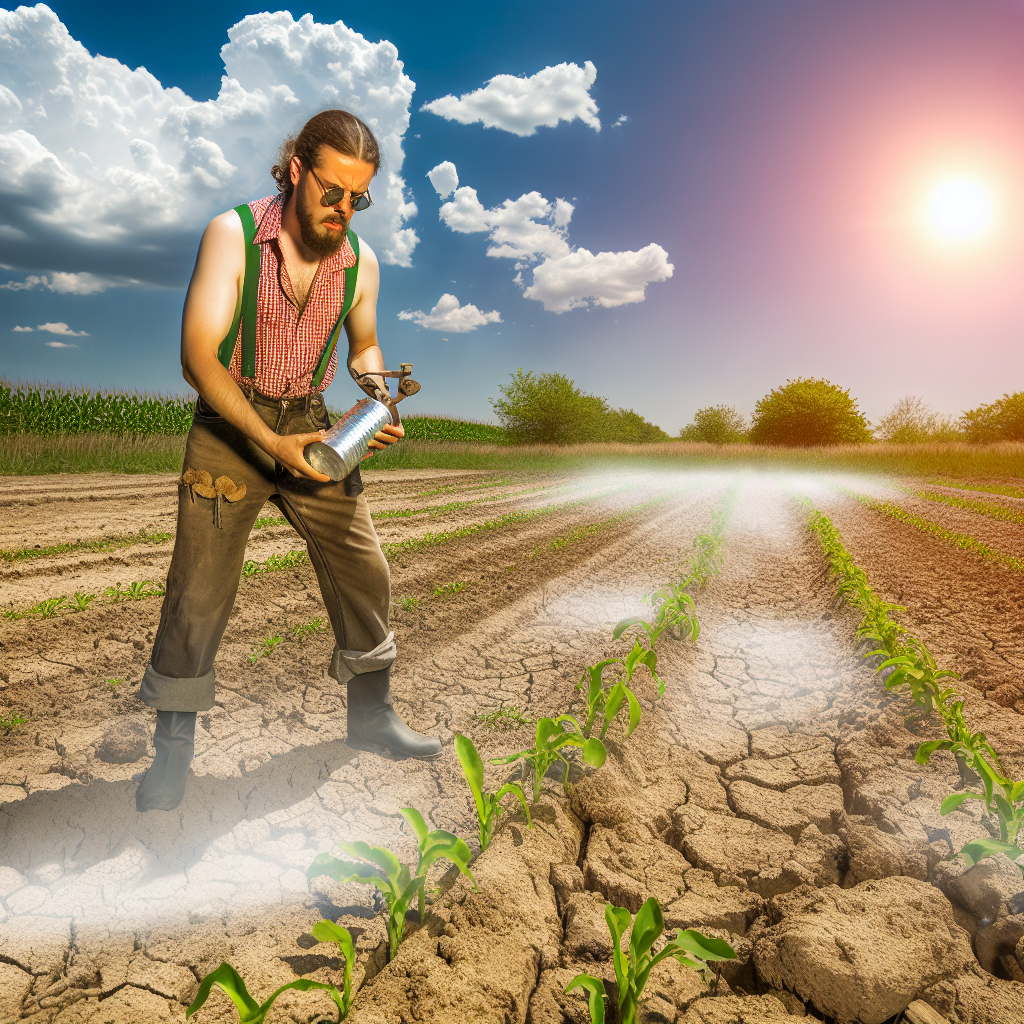Overview of Climate Change Impacts on Agriculture
Heatwaves Affecting Crop Growth
Heatwaves have become increasingly common due to climate change.
These extreme temperatures stress crops and reduce yields.
Farmers are facing challenges in maintaining optimal growth conditions.
In addition, many crops require specific temperature ranges for healthy development.
When heatwaves occur, these plants often suffer irreversible damage.
As a result, food production faces greater risks and uncertainties.
Drought Conditions and Water Scarcity
Drought significantly impacts agricultural productivity across various regions.
Prolonged periods without rainfall lead to serious water shortages.
Farmers struggle to irrigate their fields effectively under such conditions.
Moreover, water stress can weaken crops, making them more susceptible to disease.
This leads to reduced crop resilience and lower harvests.
Consequently, economic stability for farmers is jeopardized.
Interconnected Challenges
Heatwaves and drought often occur simultaneously, exacerbating challenges.
This combination stresses water resources and increases competition for limited supplies.
Farmers must adapt to these intertwined effects through innovative strategies.
Transform Your Agribusiness
Unlock your farm's potential with expert advice tailored to your needs. Get actionable steps that drive real results.
Get StartedWithout effective interventions, agricultural productivity will continue to decline.
Addressing these challenges is crucial for ensuring food security.
Technological Innovations in Irrigation
Understanding Drip Irrigation
Drip irrigation delivers water directly to plant roots.
This method reduces water wastage significantly.
Farmers can program drip systems for precise timing.
Many crops benefit from this targeted approach.
Drip irrigation also minimizes the growth of weeds.
Companies like AquaSave provide advanced systems.
Exploring Sprinkler Systems
Sprinkler systems disperse water evenly across fields.
They are particularly useful for large agricultural areas.
Modern sprinklers feature fine-tuning for different crops.
They can operate on timers for optimal efficiency.
This technology can reduce the time spent on watering.
Farms using sprinklers often notice improved yield quality.
Comparing Efficiency
Drip irrigation is usually more efficient than sprinklers.
Water savings can reach up to 60% with drip systems.
Sprinklers may be advantageous in certain soil conditions.
Farmers must assess their unique needs carefully.
The choice depends on the crop type and local climate.
Innovative Technologies in Use
Companies invest in smart irrigation technologies.
These systems utilize weather data to optimize watering.
For instance, sensors can detect soil moisture levels.
Farmers can adjust watering schedules accordingly.
As a result, they save both water and costs overall.
Showcase Your Farming Business
Publish your professional farming services profile on our blog for a one-time fee of $200 and reach a dedicated audience of farmers and agribusiness owners.
Publish Your ProfileLeading tech firms are continually developing these innovations.
Benefits Beyond Water Conservation
Improved irrigation reduces labor costs effectively.
Farmers can focus more on crop management strategies.
Additionally, healthier plants lead to higher profits.
Using technology fosters sustainable agricultural practices.
Ultimately, the environment benefits from better resource management.
Drought-resistant crop varieties: benefits and challenges
Understanding Drought-Resistant Varieties
Drought-resistant crops offer significant advantages in dry climates.
They require less water compared to traditional crops.
Consequently, farmers can conserve valuable water resources.
This innovation supports sustainable agriculture practices.
Farmers can maintain productivity even during dry spells.
Benefits of Drought-Resistant Varieties
Drought-resistant crops provide numerous benefits.
- Improved yields during water scarcity.
- Reduced reliance on irrigation systems.
- Lower production costs due to decreased water needs.
- Enhanced soil health by minimizing erosion.
Moreover, these crops can contribute to food security.
Farmers can adapt their practices to changing climates.
Challenges Faced by Farmers
Despite the advantages, challenges exist.
Adopting new seeds often requires upfront investment.
Some farmers face a lack of knowledge about these varieties.
This gap can hinder effective implementation.
Furthermore, regulatory hurdles may delay planting.
Market acceptance can also be a concern.
The Role of Research and Development
Research plays a critical role in developing these crops.
Continuous breeding efforts enhance resilience.
Organizations like the International Crops Research Institute lead these initiatives.
They collaborate with local farmers to understand specific needs.
This collaborative approach fosters innovation and adaptation.
Discover More: Climate-Smart Agriculture to Combat Greenhouse Gases
Soil Health Management Practices to Retain Moisture
Understanding Soil Health
Soil health is crucial for retaining moisture.
Healthy soil promotes better water infiltration.
Furthermore, it supports robust plant growth.
Benefits of Cover Crops
Cover crops enhance soil structure and fertility.
They reduce soil erosion by protecting the surface.
Moreover, cover crops improve moisture retention.
Farmers like Emily Thompson see real benefits.
Organic Matter Addition
Adding organic matter boosts soil’s moisture-holding capacity.
Farmers can use compost and manure for this purpose.
This strategy enhances microbial activity in the soil.
Mulching Techniques
Applying mulch conserves soil moisture effectively.
Mulch reduces evaporation from the soil surface.
Consequently, it keeps the soil cooler during heatwaves.
Implementation of Conservation Tillage
Conservation tillage minimizes soil disturbance.
Showcase Your Farming Business
Publish your professional farming services profile on our blog for a one-time fee of $200 and reach a dedicated audience of farmers and agribusiness owners.
Publish Your ProfileThis method maintains soil structure and organic matter.
As a result, it promotes better water retention.
Water-Saving Irrigation Practices
Efficient irrigation reduces water waste significantly.
Drip irrigation delivers water directly to the roots.
This practice maximizes moisture availability for crops.
Utilizing Soil Moisture Sensors
Soil moisture sensors offer real-time data for farmers.
Their use allows for precise irrigation management.
Consequently, this reduces water usage and enhances crop yield.
Gain More Insights: Top Carbon Sequestration Techniques for Farmers
Use of Data Analytics and Weather Forecasting in Farming Decisions
The Role of Data Analytics
Data analytics plays a crucial role in modern farming.
Farmers use it to enhance crop management practices.
By analyzing historical data, they identify trends in crop yields.
This process allows them to make informed decisions.
Moreover, analytics helps in optimizing resource allocation.
For example, farmers can reduce water usage significantly.
This approach conserves valuable water resources.
Additionally, predictive analytics can forecast disease outbreaks.
With timely interventions, farmers can protect their crops.
Consequently, they increase their overall productivity.
Weather Forecasting Technologies
Accurate weather forecasting is vital for farmers.
Technologies such as satellite imaging and radar provide real-time updates.
Farmers can monitor weather patterns effectively.
This information allows them to plan planting and harvesting schedules.
Furthermore, precise forecasts reduce crop loss risks.
For instance, knowing about impending heatwaves aids in preparations.
Farmers can implement measures like irrigation adjustments.
This proactive approach minimizes damage caused by extreme weather.
In summary, reliable forecasts lead to better farming outcomes.
Implementing Technology in Daily Operations
Farmers incorporate various tools for data collection.
For example, some use drones equipped with sensors.
These drones gather data on crop health from above.
Moreover, soil moisture sensors provide real-time information.
By combining this data, farmers gain valuable insights.
These insights inform irrigation and fertilization strategies.
Consequently, they enhance efficiency and reduce waste.
In addition, mobile applications facilitate data access.
Farmers can easily analyze data anytime, anywhere.
This flexibility empowers them to make timely decisions.
Collaboration and Data Sharing
Collaboration among farmers enhances data-driven strategies.
Communities often share insights and experiences.
Showcase Your Farming Business
Publish your professional farming services profile on our blog for a one-time fee of $200 and reach a dedicated audience of farmers and agribusiness owners.
Publish Your ProfileThis collective knowledge leads to improved practices.
Moreover, partnerships with tech companies drive innovation.
These collaborations often result in new agricultural solutions.
For instance, farmers may use cloud-based platforms for analytics.
Such tools enable them to analyze large datasets efficiently.
Additionally, shared data leads to better understanding of regional trends.
This information is crucial during unpredictable weather events.
Through collaboration, farmers can leverage each other’s strengths.
Discover More: Adapting to Changing Weather Patterns: Climate-Smart Farming Solutions

Adoption of Renewable Energy Solutions for Sustainable Farming
The Role of Renewable Energy
Farmers are increasingly turning to renewable energy solutions.
These solutions provide sustainable power for agricultural operations.
Using solar panels reduces reliance on fossil fuels.
Wind turbines can also generate clean electricity.
As a result, farmers lower their carbon footprints.
Solar Energy Innovations
Farmers are installing solar panels on their barns and fields.
This setup harnesses sunlight to generate electricity.
Excess energy can power irrigation systems or sell back to the grid.
Moreover, solar solutions reduce energy costs over time.
Wind Energy Integration
Wind energy offers a viable alternative in open spaces.
Farmers can install small wind turbines to capture wind energy.
This energy can power the entire farm or specific operations.
Consequently, wind energy enhances resilience against heatwaves and droughts.
Biomass Utilization
Farmers are exploring biomass energy from organic waste.
This process transforms crop residues into useful energy sources.
Biomass helps in managing waste while generating power.
In addition, it contributes to soil health and fertility.
Benefits of Renewable Energy Adoption
- Reduces overall energy costs.
- Enhances farm sustainability.
- Provides energy security during extreme weather events.
- Encourages biodiversity and reduces habitat destruction.
- Promotes a healthier environment for future generations.
Challenges and Considerations
Despite the benefits, there are challenges in adopting renewable energy.
Initial installation costs can be prohibitive for some farmers.
Also, not all locations have equal access to resources like sunlight or wind.
Farmers must carefully assess their specific situations.
Ultimately, strategic planning enhances the effectiveness of renewable energy solutions.
Discover More: The Unseen Threat: How Microclimates Are Changing the Way We Farm
Community Strategies for Sharing Resources During Extreme Weather
Collaborative Farming Initiatives
Farmers often come together to form cooperative associations.
These cooperatives facilitate resource sharing among members.
Group purchasing helps reduce costs for essential supplies.
Moreover, they enhance resilience through collective action.
Resource Exchange Programs
Communities establish resource exchange platforms.
These platforms allow farmers to trade equipment and services.
Such exchanges can include irrigation tools or crop harvesting machinery.
This system promotes efficient use of available resources.
Showcase Your Farming Business
Publish your professional farming services profile on our blog for a one-time fee of $200 and reach a dedicated audience of farmers and agribusiness owners.
Publish Your ProfileInformation and Knowledge Sharing
Farmers actively participate in community workshops.
Workshops focus on innovative farming techniques and technology.
Additionally, they share experiences related to coping with drought.
This collaborative approach fosters a culture of learning.
Emergency Response Networks
Communities create networks for fast response during crises.
These networks provide immediate assistance to affected farmers.
Support can include water delivery or feed supply during shortages.
Timely help prevents further losses amid extreme weather conditions.
Government and NGO Support
Local governments often promote community programs.
Non-profits assist with funding and resources for farmers.
Such support can strengthen community resilience.
It ensures farmers have access to necessary tools and guidance.
Policy Frameworks and Support for Farmers Facing Climate Challenges
Current Policy Landscape
Various governments are acknowledging the urgency of climate change for agriculture.
Policies are evolving to address the needs of farmers facing extreme weather conditions.
Many nations are prioritizing agricultural resilience in their climate action plans.
Financial Assistance Programs
Financial support is critical for farmers adapting to heatwaves and drought.
Programs like the Climate Investment Funds offer significant backing.
Furthermore, local government grants assist farmers in implementing innovative practices.
- Direct cash transfers to farmers during drought periods.
- Low-interest loans to support water-efficient irrigation systems.
- Incentives for adopting drought-resistant crop varieties.
Research and Development Initiatives
Collaboration with research institutions fuels agricultural innovation.
Governments are investing in projects that focus on sustainable practices.
These initiatives help farmers access new technologies and crop varieties.
Public-Private Partnerships
Private firms are joining forces with government entities to drive change.
These partnerships enhance research efficiency and speed up technology transfer.
Moreover, they create educational programs for farmers on modern techniques.
Community Support Programs
Communities are rallying to support local farmers amidst climate stress.
Grassroots organizations provide valuable resources and training opportunities.
This collaborative approach fosters resilience among farming communities.
- Local workshops on sustainable farming techniques.
- Networking events for farmers to share experiences and solutions.
- Meal programs that highlight local products to boost sales.
Future Directions
Policymakers must continue to strengthen frameworks for climate adaptation.
Investment in education helps farmers navigate changing agricultural landscapes.
Ultimately, ongoing support will sustain both farmers and food security.
Additional Resources
Chapter 5 : Food Security — Special Report on Climate Change and …




